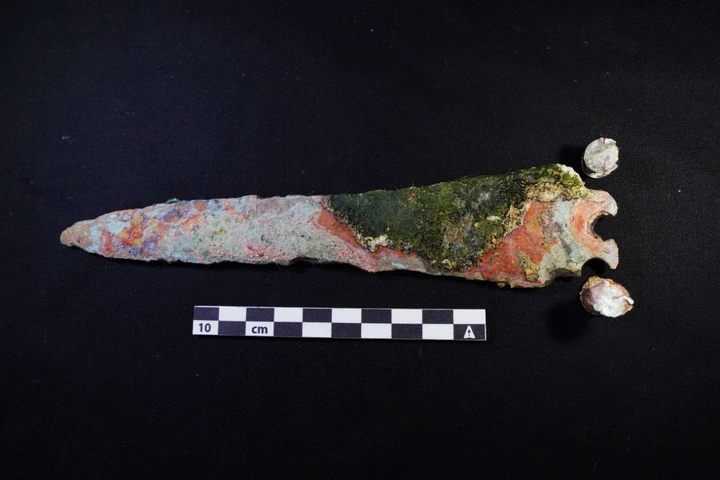
View pictures in App save up to 80% data.
This ancient artifact offers a glimpse into the lives of early humans. Crafted from flint, this dagger showcases the ingenuity and skill of our ancestors. Imagine using such a tool for hunting or daily tasks! The dagger's discovery has provided archaeologists with valuable insights into Stone Age technology and culture. Why is this dagger so significant? It helps us understand the evolution of human craftsmanship and survival strategies. Join us as we delve into 35 fascinating facts about this remarkable piece of history.
Main Insights:
- Stone Age daggers from Norway, made of flint, were essential tools for survival and had cultural significance. They varied in design and were used for hunting, crafting, and even had ceremonial value.
- Stone Age dagger research continues to uncover insights into ancient Norwegian society. Advanced techniques and interdisciplinary studies contribute to a deeper understanding of these ancient artifacts.
Stone Age Daggers: Exploring Norway's Ancient Heritage
Daggers from the Stone Age discovered in Norway provide an intriguing glimpse into the skills of ancient artisans and the everyday lives of early humans. Crafted primarily from flint, these tools were vital for survival and carried considerable cultural significance.
-
Stone Age daggers date back to around 4000-2000 BCE. This period marks the transition from the Mesolithic to the Neolithic era in Norway.
-
Flint was the primary material used for making these daggers. Flint's sharpness and durability made it ideal for crafting effective tools.
-
Daggers were not just weapons but also tools for daily tasks. They were used for hunting, cutting, and even crafting other tools.
-
The design of these daggers varied across regions. Different areas in Norway had unique styles and techniques for making daggers.
-
Some daggers featured intricate carvings and decorations. These embellishments suggest that daggers also had ceremonial or symbolic significance.
Artisan Skills and Methods
Crafting a dagger from the Stone Age demanded expertise and an understanding of flint knapping, a method for shaping stone by hitting it with a different tool.
-
Flint knapping involved precise strikes to shape the stone. This method allowed craftsmen to create sharp edges and pointed tips.
-
Craftsmen used antler or bone tools to refine the dagger's shape. These tools helped in achieving finer details and smoother surfaces.
-
Heat treatment was sometimes used to enhance flint's properties. Heating flint made it easier to work with and increased its durability.
-
Daggers often had handles made from wood, bone, or antler. These materials provided a comfortable grip and improved the tool's functionality.
-
The process of making a dagger could take several days. Each step required patience and precision to ensure the final product was effective.
Recent Archaeological Findings
Discoveries of Stone Age daggers in Norway have offered significant understanding of the lifestyles of prehistoric populations.
-
Many daggers have been found in burial sites. This indicates their importance in rituals and beliefs about the afterlife.
-
Some daggers were discovered in hoards, buried together. These hoards might have been offerings or hidden treasures.
-
Daggers found near settlements suggest they were everyday tools. Their presence in homes indicates their role in daily activities.
-
The discovery of unfinished daggers reveals the manufacturing process. These pieces offer a glimpse into the techniques and stages of production.
-
Some daggers show signs of wear and repair. This suggests they were valued possessions, maintained and used over long periods.
Cultural Importance
Daggers from the Stone Age served not only as functional instruments but also carried significant cultural and symbolic value for their creators and users.
-
Daggers were often included in grave goods. This practice highlights their importance in burial rituals and beliefs about the afterlife.
-
The craftsmanship of a dagger could indicate the status of its owner. High-quality, decorated daggers might have belonged to important individuals.
-
Daggers were sometimes used in trade and exchange. Their value made them suitable for bartering and gifting.
-
Some daggers were passed down through generations. This tradition suggests they were treasured family heirlooms.
-
The design of a dagger could reflect regional identity. Unique styles and techniques were a way for communities to express their cultural heritage.
Contemporary Research and Analysis
Scholars are actively investigating Stone Age daggers to gain deeper insights into the lifestyles and cultures of ancient Norwegian communities.
-
Advanced imaging techniques reveal details of dagger construction. Methods like 3D scanning help researchers analyze the craftsmanship.
-
Experimental archaeology replicates ancient techniques. By recreating daggers, researchers learn about the skills and tools used by Stone Age craftsmen.
-
Chemical analysis identifies the sources of flint. This information helps trace trade routes and interactions between different regions.
-
Wear analysis shows how daggers were used. Examining wear patterns provides insights into the daily activities of ancient people.
-
Comparative studies link Norwegian daggers to those in other regions. These comparisons reveal cultural exchanges and influences.
Conservation and Exhibition
Numerous Stone Age daggers can be found in museums, where they are preserved, examined, and showcased for the purpose of public education.
-
Museums use controlled environments to preserve daggers. Proper humidity and temperature levels prevent deterioration.
-
Daggers are often displayed with other artifacts from the same period. This context helps visitors understand their use and significance.
-
Interactive exhibits allow visitors to learn about flint knapping. Hands-on activities and demonstrations engage the public in ancient techniques.
-
Virtual tours and online collections make daggers accessible worldwide. Digital resources expand the reach of these ancient artifacts.
-
Educational programs teach about Stone Age life and technology. Workshops and lectures provide deeper insights into the past.
Ongoing Research
Current studies are revealing fresh insights into Stone Age daggers and their significance within ancient Norwegian culture.
-
New archaeological sites are still being discovered. Each find adds to our understanding of the Stone Age.
-
Interdisciplinary studies combine archaeology with other sciences. Fields like anthropology and geology contribute to a fuller picture.
-
Public interest in ancient history drives further research. Enthusiasts and scholars alike are eager to learn more about the past.
-
Collaborations between institutions enhance research efforts. Sharing knowledge and resources leads to new discoveries.
-
Technological advancements improve research methods. Innovations in imaging, analysis, and preservation continue to reveal new insights.
The Final Remnants of Stone Age Norway
Daggers from the Stone Age discovered in Norway provide a fascinating glimpse into a bygone era. These relics narrate tales of early artistry, the struggle for survival, and everyday activities. Crafted from flint, these implements played a crucial role in hunting, construction, and ceremonial practices. The design and craftsmanship of these tools shed light on the expertise and understanding possessed by our ancient ancestors.
Norway's abundant archaeological sites have uncovered numerous intriguing artifacts. Every dagger discovered contributes to our understanding of the lives of our forebears. These findings illustrate the ways in which humans adjusted to their surroundings and crafted tools to succeed.
Gaining insight into these ancient instruments allows us to recognize the creativity of our early ancestors. It serves as a reminder of the extensive path of human development. The next time you encounter a Stone Age dagger, consider the skilled hands that shaped it and the stories it carries. These relics represent much more than mere tools from the past; they connect us to our collective history.
Commonly Asked Questions
What precisely is a dagger from the Stone Age?
A dagger from the Stone Age represents a weapon or tool developed by early humans during this ancient period. Lasting from approximately 3.4 million years ago until around 3300 BCE, this era was characterized by the use of natural resources such as stone, bone, and wood to fabricate essential tools for hunting, cutting, and survival needs. These early daggers were mainly constructed from flint or similar durable stones, skillfully crafted and honed through a technique known as knapping.
The Stone Age daggers found in Norway are estimated to be around 4,000 to 6,000 years old, dating back to the Neolithic period.
Daggers from the Stone Age discovered in Norway may date back as far as 12,000 years, originating from the Mesolithic era. This period represents a pivotal transition, as the conclusion of the last Ice Age led to altered environmental circumstances that early humans needed to adjust to, influencing the development of their tools and weaponry.
What makes these daggers important?
These daggers hold considerable importance for a variety of reasons. To begin with, they provide valuable information about the everyday activities, hunting methods, and survival tactics of prehistoric humans. Additionally, the level of craftsmanship displayed in these tools highlights the technological progress and expertise of Stone Age communities. Finally, they assist archaeologists in tracing the migration patterns of human groups throughout Europe and their relationships with the surrounding environment.
How were daggers crafted during the Stone Age?
Creating a dagger in the Stone Age was a sophisticated endeavor that utilized a method called flintknapping. This skill involved striking a piece of flint or another appropriate stone with a hammerstone to generate sharp flakes. These flakes could subsequently be meticulously refined and molded into the form of a dagger. Achieving this required not only accuracy but also a comprehensive knowledge of the characteristics of various stones to craft a practical and long-lasting tool.
In Norway, these daggers have been discovered in various archaeological sites, particularly in regions such as Østfold, Akershus, and Vestfold. These areas are known for their rich Viking history and have yielded numerous artifacts from that era.
A variety of ancient artifacts have been unearthed throughout Norway, spanning coastal regions, riverbanks, and historic settlements. These locations present abundant archaeological layers that shed light on history, uncovering not only daggers but also a range of tools, traces of homes, and even artistic creations.
Are these daggers on display in a museum?
Indeed, numerous fascinating Stone Age daggers can be found in museums throughout Norway and Scandinavia. Institutions like the Historical Museum in Oslo and the University Museum of Bergen house impressive collections of prehistoric items, including these daggers, which illuminate the narrative of human history in the area.
The designs on some of the daggers often symbolize various cultural or historical themes. They may represent elements such as bravery, honor, or specific mythological figures. Additionally, intricate patterns could reflect the craftsmanship of the artisans or signify the dagger's origin, showcasing the unique identity of a particular culture or region.
Although not every dagger from the Stone Age showcases intricate designs, those that do often bear engravings or markings that reflect different elements of the society, beliefs, and environment of the time. These artistic motifs might depict significant animals, convey spiritual ideologies, or serve as a medium for creative expression. Analyzing these symbols provides valuable insights into the cultural and spiritual dimensions of Stone Age communities.
How do these findings enhance our knowledge of the Stone Age?
The recent discoveries of Stone Age daggers and various artifacts greatly enhance our comprehension of early human history. These findings serve as proof of technological advancements, social structures, and the ability of human communities to adjust to their surroundings. Every new artifact contributes to the larger narrative of our shared history, aiding historians and archaeologists in reconstructing the tale of human evolution and migration.
Did you find this page useful?
Our commitment to delivering trustworthy and engaging content is at the heart of what we do. Each fact on our site is contributed by real users like you, bringing a wealth of diverse insights and information. To ensure the highest standards of accuracy and reliability, our dedicated editors meticulously review each submission. This process guarantees that the facts we share are not only fascinating but also credible. Trust in our commitment to quality and authenticity as you explore and learn with us.









